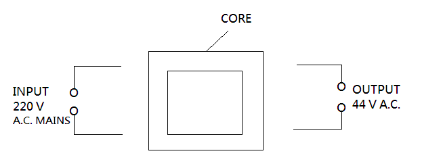
Complete the diagram of the transformer and connection by labelling all parts joined by you.


Answer
558k+ views
Hint: In the given diagram, one end is at higher potential difference while the other end is at lower difference. The given diagram is of a transformer. A transformer is a device which is capable of transferring electric current from one circuit to another circuit.
Complete answer:
As the given diagram is of transformer, we will complete the diagram accordingly. In a transformer, the coil is of iron. The core is made up of thin laminated sheets of iron.The complete and labelled diagram is given below:

There are two types of winding in the transformer. The winding on the left side (input side) is known as primary winding. The winding on the right side is the output side. The winding on the output side is known as secondary winding.
Based on the number of turns there are two types of transformers.
1) Step up transformer
2) Step down transformer
1) Step-up transformer: When the voltage at output is more than the input voltage, it is known as a step-up transformer. In step-up transformers, the number of turns in secondary winding is more than in primary winding.
2) Step-down transformer: When the voltage at output is less than the input voltage, it is known as a step-down transformer. In step-down transformers, the number of turns in secondary winding is less than number of turns in primary winding.
Note: When the output voltage is less than input voltage, the given transformer is a step-down transformer. Number of turns is important in transformers. In some transformers, the primary and secondary winding is shared through the same coil. In that case the diagram will be different.
Complete answer:
As the given diagram is of transformer, we will complete the diagram accordingly. In a transformer, the coil is of iron. The core is made up of thin laminated sheets of iron.The complete and labelled diagram is given below:

There are two types of winding in the transformer. The winding on the left side (input side) is known as primary winding. The winding on the right side is the output side. The winding on the output side is known as secondary winding.
Based on the number of turns there are two types of transformers.
1) Step up transformer
2) Step down transformer
1) Step-up transformer: When the voltage at output is more than the input voltage, it is known as a step-up transformer. In step-up transformers, the number of turns in secondary winding is more than in primary winding.
2) Step-down transformer: When the voltage at output is less than the input voltage, it is known as a step-down transformer. In step-down transformers, the number of turns in secondary winding is less than number of turns in primary winding.
Note: When the output voltage is less than input voltage, the given transformer is a step-down transformer. Number of turns is important in transformers. In some transformers, the primary and secondary winding is shared through the same coil. In that case the diagram will be different.
Recently Updated Pages
A man running at a speed 5 ms is viewed in the side class 12 physics CBSE

The number of solutions in x in 02pi for which sqrt class 12 maths CBSE

State and explain Hardy Weinbergs Principle class 12 biology CBSE

Write any two methods of preparation of phenol Give class 12 chemistry CBSE

Which of the following statements is wrong a Amnion class 12 biology CBSE

Differentiate between action potential and resting class 12 biology CBSE

Trending doubts
What are the major means of transport Explain each class 12 social science CBSE

Which are the Top 10 Largest Countries of the World?

Draw a labelled sketch of the human eye class 12 physics CBSE

How much time does it take to bleed after eating p class 12 biology CBSE

Explain sex determination in humans with line diag class 12 biology CBSE

Explain sex determination in humans with the help of class 12 biology CBSE




